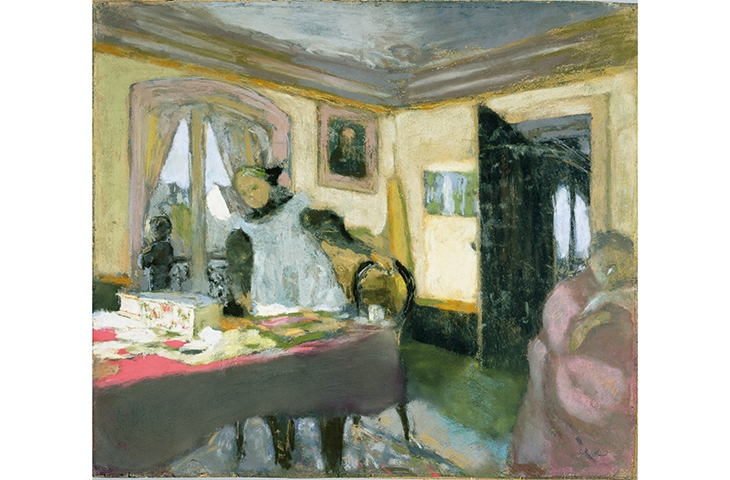Fin-de-siècle Paris was not just the art capital of the world, it was also the fashion capital. In 1901, 300,000 Parisians were employed in the rag trade, and one of them was Édouard Vuillard’s mother.
Stout, sensible and self-sufficient, Mme Marie Vuillard was no Mimi out of La Bohème, embroidering flowers in a draughty garret. She was the independent patronne of a dressmaking atelier — more of a couture flat, admittedly, than a couture house, operating out of rented apartments in the garment district. Before being left a widow with three children, she had prudently invested in a small business producing dresses and made-to-measure corsets for a fashion-conscious petit bourgeois clientele. With her seamstress mother and daughter Marie —coincidentally known as Mimi — among her employees, Mme Vuillard was a multitasking materfamilias, managing the workshop and the household while supporting her son Édouard in his artistic ambitions.
Édouard returned the favour by featuring his mother in more than 500 paintings, of which a small selection is on show at Birmingham’s Barber Institute in a charming exhibition marking the 150th anniversary of his birth. Centring on the Barber’s own ‘Madame Vuillard Arranging her Hair’ (1900), these intimate pictures are a radical departure from the usual French fin-de-siècle celebrations of woman as love object, let alone sex object. They’re a celebration of ‘her indoors’ from a filial perspective: images of female domestic industry and the atmosphere in which it was wrapped — an atmosphere Vuillard had breathed since childhood.
He was still living at home, aged 61, when his mother died in 1928. The homes changed as one small rented flat was exchanged for another but the domestic routines continued uninterrupted, the women sewing around the dining-room table while the man of the house painted in his ‘bedroom studio’. We recognise the same pieces of furniture — the dining table, straight-backed chairs and large armoire, its mirror complicating the fiddly perspectives of the cramped spaces.
Above all, we recognise the figure of Maman, sewing, cooking, cleaning, dishing out parental advice, tending the sick — if not centre stage, then on the periphery of vision, a comforting presence glimpsed through doorways, part patronne, part skivvy; a domestic goddess worshipped by her son.
With their keyhole views of women in confined spaces, Vuillard’s small interiors feel closer to the Dutch Golden Age than to French post-impressionism, but unlike the patterned surfaces in Dutch paintings — the tiles and rugs — his patterning is pretty much wall-to-wall. Between the wallpaper, carpets, upholstery and fabrics worn by his women there is barely a chink. Everything feels wrapped in a familial fug. More air is let into lithographs such as ‘The Cook’ (1899), a proto-kitchen-sink image of his mother drying up; the paintings, by comparison, are thick with smudges replicating the muzziness of memory. You have to get in close to unlock the puzzle and even then you can’t always tell what’s what. The ‘Two Seamstresses in the Workroom’ (1893) are as well camouflaged as tropical fish on a coral reef.
There’s nothing voyeuristic about these images. Vuillard is an insider, not a voyeur; his women are almost part of the furniture. A revealing entry in his journal records his reaction on waking to find his mother among the familiar furnishings of his bedroom: ‘In the middle of all these objects I was astonished to see Maman enter in a blue peignoir with white stripes. The arrival of Maman was surprising — a living person.’
Some pictures hint at stories. ‘The Chat’ (1893), which shows his sister in her wedding dress blushing into her corsage as Maman delivers the dreaded last-minute sex talk, could be a scene from one of the suffocating symbolist dramas for which Vuillard was designing sets at the Théâtre de l’Oeuvre. The soon-to-be marital bed leering in the background plays as important a role as the two figures. Beds take centre stage in other pictures: a sickbed in ‘The Lullaby’ (1894), in which Maman watches over a feverish Mimi; a deathbed in ‘Woman near Bed’ (c.1893), where she keeps vigil over a hump of bedding that possibly conceals her dying mother.
In the late 1890s Vuillard acquired a hand-held Kodak. A few of the hundreds of photographs he took of his mother — who printed the photos from negatives in a soup bowl — are in the show. In the last one, taken in the year of her death, she is towelling her feet after a bath. The pose could be from a drawing by Degas, except that the model is 89 and bald, her shrunken body dwarfed by the high ceiling of the spacious apartment her successful son can now afford. As an image, it is too intimiste for comfort. Vuillard didn’t paint it, but only eight years earlier he confessed to his first biographer: ‘Maman, c’est ma muse.’






Comments